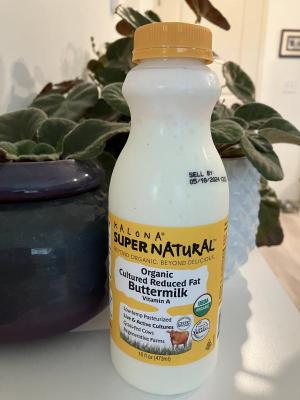I bought a bottle of buttermilk to make biscuits, which got me thinking about this oddly-named ingredient. Originally, buttermilk referred to the liquid that remained in the butter churn after the cultured cream had been transformed into butter. Today, what you will more likely find labeled “buttermilk” is a fermented liquid made from skim milk, more akin to a drinkable yogurt or kefir.
The taste and texture of the two versions differ: true buttermilk is thinner with a more complex flavor than the modern manufactured buttermilk which has a more noticeable acidity. This version is made by adding lactic acid-producing bacteria to milk to “culture” it in a controlled environment. The acid lowers the pH, precipitating the casein proteins, causing the milk to clabber or thicken.
The origins of buttermilk are as old as humanity; we have been drinking sour milk for most of human history. Before we had the ability to keep foods cool under some sort of refrigeration, milk would ferment as it was affected by naturally occurring bacteria. These would digest lactose, the sugar found in dairy products, creating lactic acid, which both prevents harmful bacteria from spoiling the milk and adds tart flavor and thick texture.
Milk has been collected from cows, sheep, goats, and buffalo for millennia, providing the primary ingredient for cheese, butter, and fermented beverages. The butter-making process is the source of true buttermilk. As the milk is left out, its cream content rises to the top. In this cream, you’ll find a higher concentration of fat globules, which are smushed together during churning to create a solid chunk of butter.
In his book, “The Curious Cook,” Harold McGee describes the creation of butter through churning these fat molecules until they fuse. The beloved by-product that we call buttermilk, contains bits of the membranes of these ruptured molecules, which are rich in emulsifiers. This feature makes buttermilk a key ingredient in fine-textured foods, such as biscuits, breads, and ice cream. It was also used as the base for red barn paint by the Pennsylvania Dutch.
How does buttermilk work in recipes? The acid reacts with baking soda in the batter to create air pockets in the batter and the buttermilk tenderizes the gluten, resulting in light, airy baked goods. In salad dressings, its emulsification helps with body, texture, and tang. Next time you make fried chicken, rest the pieces in a bowl of buttermilk to tenderize them, then use more buttermilk in the batter for a crisp crust.
Buttermilk in a smoothie is a great way to add beneficial bacteria to your morning drink. Consider substituting buttermilk for the liquid used to whip mashed potatoes or use it in your next batch of coleslaw. Buttermilk adds a wonderful creaminess to homemade ice cream and pairs nicely with any fruit pieces you might mix into the custard.
The ancient Egyptians considered buttermilk sacred and were known to have used it in their skin care regimes. They were definitely onto something, as many modern cosmetics include lactic acid as an ingredient. You can find all sorts of beauty tips that suggest smoothing your skin with buttermilk. To give you some places to use your next bottle of buttermilk, I’ve included recipes for biscuits, a traditional corn pone and an addictive ranch dressing.
Buttermilk Biscuits
2 C flour
2 t sugar
1 T baking powder
1/4 t baking soda
1 t salt
6 T unsalted butter
1 C chilled buttermilk
Preheat the oven to 450F. Line a baking pan with parchment paper; set aside. In a large bowl, combine flour, sugar, baking powder, baking soda and salt. Use a pastry blender to cut the butter into the flour mixture until it resembles coarse meal. Stir in the buttermilk until just combined, the dough will be slightly sticky. Turn out the dough onto a floured surface and dust the dough with flour. Gently pat the dough out until it’s a 1/2-inch in thickness. Use a 2-inch round biscuit cutter to push straight down through the dough to cut out circles. Place the biscuits on the baking sheet, two inches apart. Bake the biscuits until golden brown, about 12 to 15 minutes. Yield: 20 biscuits.
Corn Pone*
2 C corn meal
4 T sugar
1 t salt
3 C boiling water
6 T butter
2 beaten eggs
1 1/2 C buttermilk
Preheat oven to 350F. Coat the inside of a 9 by 9-inch baking dish with nonstick cooking spray; set aside. Combine corn meal, sugar, and salt in a mixing bowl. Pour in boiling water and stir together until smooth. Add butter and stir until melted. Whisk in eggs and buttermilk. Transfer batter to prepared pan and bake until set, about 45 minutes to an hour. Allow to rest for 15 minutes to firm up before cutting into squares. * Adapted from Elaine Mitchell.
Ranch Dressing
1/2 C mayonnaise
1/2 C sour cream
3/4 C buttermilk
2 cloves pressed garlic
1/4 C chopped parsley
2 T chopped dill
2 T snipped chives
1 1/2 t salt
1/2 t black pepper
1/2 t onion powder
Pinch cayenne pepper
In a medium bowl, whisk together wet ingredients Add seasonings and stir until combined. Store covered in the refrigerator for up to one week. Yield: 2 C.






















































